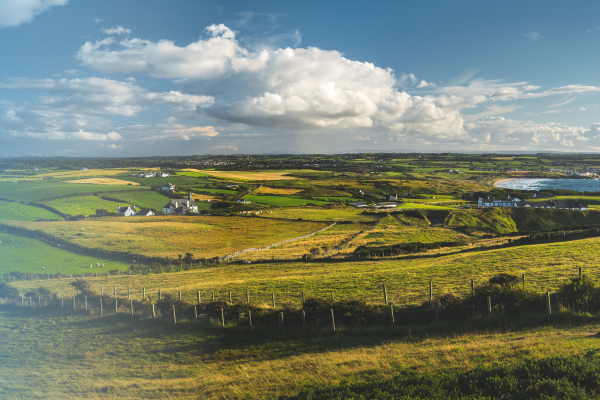Business and Policy July 2025 – Greenhouse Gas Emissions and Nitrogen Use in Scottish Agriculture
30 June 2025Earlier this month, the Scottish Government published its annual experimental statistics report entitled Scottish Agriculture Greenhouse Gas Emissions and Nitrogen Use: 2023–24. The report presents findings from data gathered on 400 commercial farms participating in the Scottish Farm Business Survey. It focuses on:
- Whole Farm Greenhouse Gas (GHG) emissions as calculated using Agrecalc.
- Emissions intensity of products by farm type, measured in kg CO₂e per kg of beef, lamb, milk, and per tonne of grain.
- Nitrogen use and Nitrogen Use Efficiency (NUE) by farm type.
This dataset represents 94% of the standard output from the 10,500 farms in Scotland’s traditionally supported sectors. A sample of the emission intensity results are shown below:
Table 1: A sample of results including emission intensity kg CO2e/ kg of product for beef and sheep in the various farm types
Livestock farm beef and sheep emission intensities, 2023-24
| Unit | Beef kgCO2e/kg dwt | Sheep kgCO2e/kg dwt |
|---|---|---|
| Farm type | Average (median) | Average (median) |
| LFA cattle and sheep | 32.84 | 31.1 |
| Lowland cattle and sheep | 30.9 | 25.2 |
| LFA cattle | 31.75 | --- |
| LFA sheep | --- | 35.5 |
This year’s farm-level results are presented in the context of the National Inventory for Scotland’s Agriculture sectoral results. The National Inventory tracks and reports GHG emissions across all sectors of the economy. It enables governments to monitor progress toward climate targets and provides critical insights to guide policy development – helping Scotland meet its international commitments in addressing the climate emergency. In short, the National Inventory informs policy. Government then uses policy levers to drive change in farm businesses to deliver on climate goals. So, while these results may seem far removed from the farm gate, they will influence what happens within it.
In last month’s Business and Policy News, we reported on the 2025 Climate Change Committee report, which outlined the significant changes required in agriculture and food consumption to meet future GHG emissions targets beyond 2038. Among the recommendations was a 25% reduction in agricultural emissions over the next 10 years.
What does this mean for the industry?
Policy development will increasingly focus on practices that reduce farm emissions and align with the type of farming the government aims to support in the future. Many of the proposed measures have a strong knowledge component, including:
- Animal health and genetics.
- Feeding and nutrition.
- Soil management.
- Improving use of nitrogen on farms.
Knowledge-based interventions are likely to be at the forefront of future policy and agricultural scheme development. This shift brings with it a growing need for robust data and farm-level benchmarks – not only to monitor progress from the top down via the national inventory, but also at a granular level across different farm types and in emission intensity figures for individual products.
One of the strengths of resource use as a benchmarking tool is that it removes financial performance from the comparison, allowing for a clearer focus on efficiency and sustainability. Efficiency inevitably means improved profitability.
Why this dataset matters
The introduction of this national dataset for farm-level GHGs is a welcome development for both industry and farmers. Climate science and carbon calculator tools are evolving rapidly, improving in reliability and functionality, and delivering increasingly robust data. This is good news for the sector: what gets measured, gets managed. The more reliable the data on resource use, the better equipped the industry will be to support change and improve farming practices.
This dataset is valuable not only for providing a reality check for policymakers – helping to manage both policy and industry expectations, but also for supporting on-farm decision-making, benchmarking, and action. A robust baseline is essential for understanding where a farm or croft stands and for measuring the impact of interventions, whether annually or every 3–5 years in the case of a carbon footprint assessment.
As the data landscape continues to evolve, these farm-level GHG and nitrogen usage statistics will help inform what kind of baseline individual farms can work from in the future and what the industry norms for comparison might look like.
Sascha Grierson, Sascha.grierson@sac.co.uk
Further Information
Scottish agriculture greenhouse gas emissions and nitrogen use: 2023-24
Scotland’s Carbon Budgets – Climate Change Committee
Business and Policy June 2025 – Policy Brief | Helping farmers in Scotland | Farm Advisory Service
Greenhouse Gas Abatement in UK Agriculture 2024-2050 – SRUC
Sign up to the FAS newsletter
Receive updates on news, events and publications from Scotland’s Farm Advisory Service

